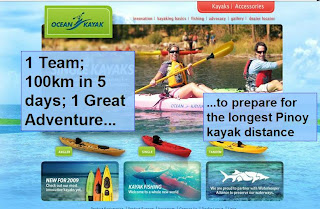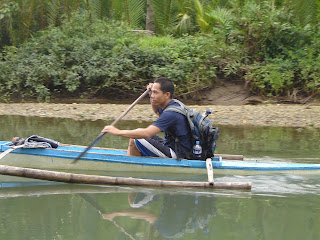
 Noveleta Cavite to Pasay Mall of Asia (~29km)
Noveleta Cavite to Pasay Mall of Asia (~29km)
As a show of support to Swee (who’s doing an epic ride from the southernmost tip of Mindanao Island to the northernmost tip of Luzon Island - visit
http://friendshipkayak.com/blog/category/blog-entries/ ), I struggled for several weeks to get good kayaks for a would-be UPM kayak team. But as fate would have it, we didn’t get funds to even rent a boat.
Down to a desperate attempt to show that support, I felt compelled to kayak for at least 1 day, using my inflatable. Hey, it’s generally ok but long distances could make my life a bit more difficult, and I might even invite danger especially if we’re riding thru tricky waters (which the inner Manila Bay has proven given the presence of thousands of sharp bamboos and sticks meant as fish pen posts).
Since I would be using a tandem (my only inflatable boat), and since I have not kayaked for more than 20km in a single go, I invited an experienced, trusted adventurer from UPMountaineers as my co-paddler - Danny Dematera - an ultra-marathoner, all around endurance athlete, and a dragon boat racer. Danny was quick to say Yes, eager to try something relatively new.
The next critical thing would be our plan and route. Well, the funny side of route planning was that, we were never sure where Swee will start his Manila Bay leg, or when, or how the incoming and outgoing typhoon will affect us. I’ve come up w/ like 4-5 alternatives, and initially thought of doing a 2-day stint starting from Naic Cavite (around 40km from Mall of Asia in Pasay).
Finally, I got a text message from him, confirming his ‘most likely’ schedule for end-Oct and start of November. Unfortunately, because of the typhoon threat and office schedule, I could only do 1-day (Nov2), and so I changed the plan a bit more - our route was just merely overlapping with Swee’s. A small hope of meeting in the water.
Swee mentioned that he’s typically doing 7kph, w/c alarmed me be a bit, as I’m only used to around 4kph using my tandem inflatable (i.e. it’s not meant for speed). This means that I have to either start ahead of time, OR, put a good distance between us. I did the latter, having around 20km gap. 10km should be sufficient enough, but the town before Noveleta (i.e. Rosario) didnt offer resorts, or any good starting point. Looking back, 20km was too much. :)
Danny and I went to Noveleta Cavite the day before. In my mind, the starting point has to be a resort (I need a good sleep, good food, and less ‘audience’ during set-up and take off). Surprisingly enough, there are resorts in both Tanza and Noveleta Cavite (my candidate starting pt towns). Of course, that’s Manila Bay so I guess resorts were not that popular even for us beach-combers.

The ‘good food’ part was ok (I bought litson manok on the way), but the accommodation was crappy. I was wearing my kayak outfit (long sleeves rashguard) during the night to avoid mosquito contacts. I was not very successful.
The next day, we woke up early, set up our kayak, and pronounced – Ready! Danny, not being used to inflatable set-ups, gladly remarked “
Ayan, mukha na syang kayak!”. Haha! The boat was initially deflated, folded, and just looked anonymously like a big bulky something that doesn’t resemble a boat.
Soon we mount the kayak, and for some strange phenomenon, out of the blue, off the calm – flat waters of Cavite, 2 consecutive 2-3-foot rolling waves suddenly appeared from nowhere and ‘greeted’ us unexpectedly. Luckily, our kayak was positioned at 12o’clock, preventing an early capsize, but the roll was strong enough for us to have our own little mind games of a possible incoming disaster. Those 2 were the last of the strong waves that we encountered thru-out, so we just called them ‘welcome waves’.
We paddled strong and hard, Danny leading the pace. I was a bit concerned as I’m not used to this speed, but trusting Danny, the power-man, was all I could do. He follows a bit of different strategy as I do in alpine climbing – and his motto “go fast at first until you run out of strength” hahaha, a bit of gung ho style in my opinion, but I was ok given the day-only trip that we planned.
We focused our energy in paddling, and I – especially to keep up w/ Danny’s power row. Fortunately, the weather and sea were very calm, a bit of little rolling waves and insignificant swells here and there but generally ‘flat’.
We soon hit a 6km mark (in my mental map), and I was surprised that it was only around 1:10h of effort – “We’re doing almost 6kph!” I relayed that to Danny, inviting him to go slow and to have a better chance to meet up with Swee’s team. He suggested that we’ll soon be tired and get slower anyway, so we’ll just keep our pace ‘til we run out’. In my mind, we’ll rest in Island Cove (half-way mark) anyway – so I guess we’ll meet Swee regardless.
During the first hour, we already felt that something is wrong with our boat set-up. That would be my fault since I should know how to set up the kayak properly. When I bought the kayak, there’s only rigid material that supports that aft and bow, but nothing in between. Months before our trip, I already rode the kayak a few times and made some adjustments in the setup – i.e. I put 2 rubber mattress ‘lining’ on each side supporting the main bladder, to reduce sagging and drag.
For some reason, Danny’s port side (that’s on his left) was a bit ‘crumpled’ creating unnecessary drag - and forcing us to paddle harder on the left-hand side. To stop or not to stop? As mountaineers, we breathe and live the word ‘
tiis’, so we just ignored the ‘inconvenience’ and paddled on.
After covering around 10km, and as we were crossing Canacao Bay – we both agonized the paddling as the feeling then was like rowing on a sea of thick oil. We were paddling at the same pace, but somehow – the feeling was that – we were gaining very little distance. Danny even shared that he felt ‘
toinked’ in this section, I guess a bit of a morale stab given the lack of ‘progress feeling’. In truth however, I believe we were kayaking at the same speed (5.5 to 6kph) but the flatness of water, and windless condition (Canacao is between 2 land masses) – it would feel and seem that we were not gaining distance as we paddled.
On to our paddling, we started encountering numerous fishpens, even slide over 1 pointed bamboo – scaring the shit out of me. We’re not within easy reach of anyone, and even w/ the 3-layer system of my inflatable, “bad luck-stick” can easily puncture the hull and sink us instantly. We slowly navigated the fish pens, looking for tell-tale signs of boat ‘pathways’.
Soon we reached Island Cove resort, and to my surprise – there was nowhere to dock, or land as the area was cordoned off by either fishpens, or fences. I was intending to dock and eat lunch at their restaurant, to wait for Swee.
By then, we’ve reached halfway mark in just around 2.5hours. I underestimated our capability, Swee’s team has no chance in overtaking us given our lead (i.e. handicap distance).
We continued kayaking and decided to hit the mainland coastline to eat. We docked and rested, and stretched for a bit, when I got a text message from Swee saying “we’re now in Rosario, where are you?” If I’ve known about our speed capability, we could have started further south, or even start very late. Rosario was about 10km further south of were we’ve started (& our initial direction is northbound). We were ahead by around 25km! There goes my poor planning and wrong assumptions. ;)
I advised Swee that we’ll not be able to meet anymore, and we’ll go ahead to MOA. He plans to stop and rest in Island Cove and continue the next day (sadly, Nov3 is not a holiday for me). I promised him a Manila meet-up and story catch-up, over a round of beer.
Danny and I fixed our boat problem (put 2 rubber matts on the port side), and ate a little bit. I suggested that we eat proper lunch at MOA instead of eating in the muddy, polluted water around us. I couldn’t bear to eat our spam and bread lunch w/ my wet-from-Manila-Bay hands. “
Ang arte!” :p
We continued kayaking, we avoided the fishpens and headed northwest for a little bit, until reaching almost the half-way pt between MOA and Sangley pt. Then it was a windy, little swelly rowing from then on. Mid-sea kayaking gave us the impression of an ‘endless effort’, and of gaining insignificant distances.
We hit the near-shoreline soon, and eventually reach MOA. To our surprise, we did 7kph the 2nd half of the journey! Sure with aching shoulder and back muscles, but a pleasant surprise to discover that we can perform even with a cumbersome inflatable.
Danny initially suggested that we stop at the Yacht club (the 'base' of dragon boat teams), maybe an additional 3km, but as we hit the coast of MOA, we felt the hunger and decided to land.
Not very surprising, the guards tried to stop or scold us, I reasoned that the boat condition was not fine and that we need to immediately dock (-“we were hungry” is the more urgent reason).
I’m still wondering why unarmed, sporty-looking individuals are not normally allowed to just dock in our coast, when people in their cars, or those walk-ins are ok. Why the bias? I can fold my kayak and it’s not a hassle to anyone. Should we educate our establishments that boats were there since pre-historic times, and we only use cars a century ago? ;p Anyway, dumb as it seems, our typical policy of ‘boats- off limits’, even in beach resorts, seems to be the default, discouraging boat enthusiasts or adventurers from maximizing this travelling tool, or in promoting paddling eco-tourism.
Anyway, after quick chat with the guards, and after they radioed ‘help’ to their superiors (and got further instructions from their bosses), they let us go (what the f* will they do, jail us?). I told them that we’re paying customers, and that we’ll eat in one of the resto, at least that was the argument.
We ate at Harbor View (grilled food) restaurant, and Ahhh – food never tasted so good after almost 30km of kayaking!
We soon packed our gears, and headed home. It was for me just a starting pt experience, of more great kayak adventures to come.
Sa uulitin!



















